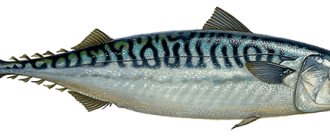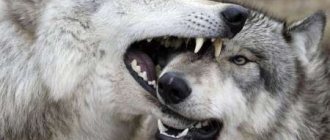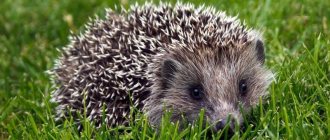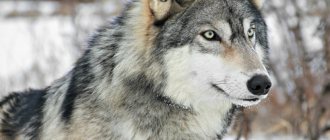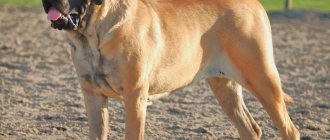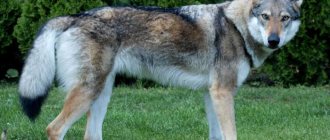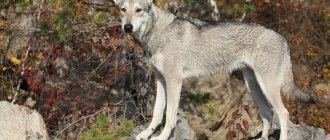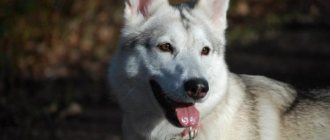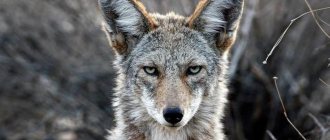Scientists continue to study these unique animals, because even today some facts about their life elude biologists. The animals are distributed throughout the world; the largest wolves live in Russia, Alaska and Canada. Several decades ago, the ancestor of the gray wolf was found. Its length was over 2 m, and its weight was more than 100 kg. Similar representatives of the canine family no longer exist, but its descendants are striking in their size.
Gray wolf
The largest representatives of the canine family live throughout North America and Eurasia, but the largest specimens of this species are found in Russia.
Their weight can exceed 100 kg, body length with tail up to two meters, height at the withers quite often exceeds one meter. Under natural conditions, life expectancy is 12–15 years.
Fluffy, dense fur visually increases size. The animal is capable of reaching speeds of up to 65 km/h. The color of the common wolf varies from gray-brown to ocher, depending on the habitat. In North America there are representatives of this species with black fur.
Wolves live in packs of up to 40 representatives. It is headed by a leader. He, like his female, are respected by other individuals. Wolf cubs are born blind and helpless; in one litter, from 3 to 12 cubs are born.
Interesting! A wolf's nose is 14 times larger than a human's. They are able to distinguish 200 million shades of smell, but humans can only detect 5 million.
Predators go hunting in the dark. Preferences in food are given to artiodactyls, but they can also be content with smaller animals, birds, and in some cases, carrion.
The black wolf killed in the Leningrad region was the toy of the rich
The “secret” of the Black Canadian wolf from North America, shot in the Leningrad region, was revealed by 47News readers. The other day 47News wrote about an amazing incident that occurred in the Leningrad region. During a driven hunt, hunters killed an animal that is unusual for Russia - a black Canadian wolf, which is found mainly in North America.
A variety of versions have been put forward regarding the appearance of a mysterious creature in our region - from mutation, which led to the appearance of such a “specimen”, to the migration of a wolf from Alaska to Russia.
Regular readers of our portal also put forward their version. So, our regular reader Peter G. contacted the editors of the 47News portal, who lifted the veil of secrecy about the “Black Canadian Wolf”. “I was very amused by scientists’ suggestions that the black wolf could have appeared as a result of a “dominant genetic mutation,” so I decided to clarify this “mysterious” story and help specialists understand the puzzle,” said Peter G. The man said that several years ago, an acquaintance of his from the city of Syasstroi purchased three Canadian wolves on the “black” market. The wolves lived at the dacha in a special enclosure, fenced with a metal mesh, and delighted the eyes of the owner, who happily showed off the strange animals to friends. “Three years ago, one of the pets ran away,” says Peter. — When the workers approached to feed the animals, one of the males, taking advantage of the staff’s inattention, slipped out the slightly open door and ran into the forest. The 47News reader is sure that it was this wolf that was shot by hunters in the Leningrad region. According to Pyotr G., it was never possible to catch him; his friend’s employees tried to track down the predator, but his trace was lost somewhere in the Ladoga region. Later, two other animals were sent to the private mini-zoo of the sports and recreation complex in Toksovo. They are still there. The administration of the complex could not remember how they got these pets. “Someone gave us the animals six months ago,” the establishment commented. The famous St. Petersburg artist Yulia Ivanovich also agrees with Peter’s version. The woman is a big lover of these freedom-loving animals. She succeeded in crossing a black Canadian wolf and a Canadian malamute and producing offspring of a new breed of dogs - wolfhounds. “I heard about this case, I also heard that the animal was young,” says Yulia Ivanovich, “And therefore I do not agree with the version of the mutation, since up to three years old wolves usually live in a pack, and not alone. Most likely, this is another exotic toy of rich people who threw their annoying pet out onto the street.”
According to Yulia Ivanovich, in Moscow, for example, there is a married couple who sell wolf cubs of a black Canadian wolf and a European wolf at a cheap price. There is a demand for this. Often people, having played enough, release an animal unadapted to “wild life” into the forest. Where it dies or becomes the prey of hunters.
polar Wolf
One of the rarest species among giant wolves lives in the vast Arctic, its body is covered with thick, dense snow-white fur, which perfectly protects from severe frosts and harsh northern winds.
The weight of representatives of this species varies from 65 to 85 kg, the height at the withers does not exceed 80–82 cm, the length without tail is between 130–150 cm. Life expectancy is about 7 years.
On barren plains covered with snow and ice, there are great difficulties in obtaining food. The main food source is hares, lemmings, reindeer, and musk ox. The wolves' bodies have adapted to go without food for a long time, but when luck smiles, they can eat up to 10 kg of meat at a time. Starving wolves often swallow hares along with bones and fur.
Polar wolves live and hunt in packs, the number of individuals in a group is no more than 25. Up to 5 cubs are born in one litter.
The number is decreasing every year. The cause of extinction is not only the impending global warming, but also poachers who are attracted to their beautiful fluffy fur.
Arctic wolves are listed in the Red Book; hunting them is strictly prohibited.
Melville Island wolf
Predators are most common in North America. The rather large wolf is slightly smaller in size than the previous species.
Its length is approximately 90–180 cm, height – up to 80 cm. Males are much larger than females, the difference in weight varies from 30 to 45 kg. Adult males can weigh 80 kg.
The color of the animals is light white, cream, occasionally with a gray or bluish tint. The belly is covered with white fur. Compared to other representatives of the canine family, the animals' limbs are quite short.
The Melvelian wolf has small, rounded ears. The further north they live, the smaller their ears are; this feature helps them retain heat.
Melville wolves can survive in difficult arctic conditions. Animals are perfectly adapted to cold weather and can endure even the coldest winters. In these parts, temperatures often drop to -50 °C.
It is quite difficult for them to find food; hunting does not always end successfully for predators. They often eat carrion. During severe cold weather, wolves hunt small animals; at other times, even moose become their target. An adult male needs about 5 kg of food per day. Representatives of this species unite in flocks of 7–10 individuals.
Wolves place their homes on rock ledges or inside caves. What distinguishes them from the rest is their strong attachment to their fellow creatures. Difficult climatic conditions influence their behavior; predators prefer to stay together.
Eurasian (European) wolf
The most common subspecies of the gray wolf lives mostly in Europe and Central Asia.
The weight and height of wolves varies depending on the region. The largest reach a size of 74–76 cm and 69–74 kg at maturity. Such indicators are typical for males; female wolves are 10–15 cm lower and weigh up to 65 kg.
The body of the animals is covered with thick and short hair. The color of Eurasian wolves is quite varied. There are individuals of white, black, gray, red, light cream color. There are also individuals in nature that have a combination of colors.
Representatives of this subtype go hunting in packs. They mainly feed on medium-sized animals: deer, wild boar, mouflon, saigas. On European territory, the largest prey is considered to be the bison, and for the inhabitants of Asia - the yak. Predators do not disdain hares and frogs.
The largest wolf of this subspecies, weighing 72 kilograms, was killed in Romania.
In times of famine, alone, European wolves get closer to people. In search of food, they rummage through landfills and feed on food waste along with dogs.
Rocky Mountain Wolf
The habitat of the largest individuals of the gray wolf subspecies is the northern Rocky Mountains of North America. Sir John Richardson was the first naturalist to identify this subspecies in 1829. He also gave the name to gray predators based on their main habitat.
The length of an adult wolf ranges from 66 to 81 cm, weight 32–68 kg.
The body is covered with a thick layer of beautiful light gray fur, the chest is white. A wolf pack contains 8–12 individuals, but sometimes larger families of up to 40 animals are found.
In the middle of the last century, the population of Rocky Mountain wolves declined greatly, and they were taken under protection. Thanks to the timely adoption of measures, the number of individuals increased after just a few years. In 2012, this subspecies was removed from the list of protected species.
Hardy and very strong wolves easily hunt large representatives of artiodactyls. The diet of Rocky Mountain wolves mainly consists of bison, musk oxen, deer, and bighorn goats. During hungry periods, predators can be content with squirrels, hares, beavers, and lemmings.
Maned wolf
The maned wolf is one of the largest representatives of the canids. Lives in South America. Has a rather unique and unusual appearance. It looks like a fox, the body is short, but the legs are high.
The wool is soft, yellowish-reddish in color. Prefers open grassy plains where there is opportunity to observe. It usually comes out at night. Hunts small animals - rabbits, reptiles, ducks, insects.
Wolves produce a slightly unusual howl that can only be heard after sunset. Currently in danger of extinction.
Mackensian plains wolf
This subspecies is one of the largest wolves in North America. Habitat - western parts of the mainland, the largest population is in western Canada, Alaska and central Idaho. There are 10,000 individuals of this subspecies in total.
At the withers, the animals reach 91 cm, although the body weight of wolves does not exceed 65 kg. The largest wolf of this subspecies was caught in Alaska in 1939, weighing 79 kg.
The fur of adults is very thick and fluffy. During the cold winter period, wolves are saved from the cold by their undercoat, which they shed with the onset of warm spring days. Coat color varies from white to black. The body of the Mackenzi plain wolf differs from other species in its proportional shape. Thick, muscular and rather long limbs allow them to move quickly over rocky terrain and not get stuck in deep snowdrifts.
Mackensian plains wolves have the largest and lightest paws of all representatives. The huge size of their lungs allows them to breathe deeply on the tops of mountains. Animals have a large reserve of energy, allowing them to cover 100–115 km per day.
The wolves of the Mackenzie Valley are not only among the largest in the world, but also, thanks to their luxurious thick “fur coat,” they are considered one of the most beautiful representatives of the canine family.
Wolves hunt mainly elk, reindeer, musk oxen, and bison. They choose prey among those who lag behind the pack or are exhausted. They pursue the victim one by one, waiting until the deer or elk gets tired and only then tearing it into pieces.
Red Wolf
The red wolf is considered a rather rare representative of predatory animals. Currently it is an endangered species. Found many times in central and southeast Asia. There is no reliable information about their origin. But presumably the ancestor is a marten. What makes it different from others is its bright red coat color.
Adults have a brighter shade, while older ones are pale. Can be seen in national zoos. They live well on rocks and in caves. They feed on small rodents, hares, raccoons, wild boars, and deer.
Canadian wolf
A resident of the North American continent is one of the largest subspecies of the gray wolf.
The size of the animal depends on its habitat. The colder it is, the larger the wolf. On average, the height at the withers is 60–85 cm, length 105–160 cm, weight 32–62 kg.
Incredibly fast predators, whose speed can reach 70 km/h, are considered one of the most dangerous animals. Game rarely manages to escape their tenacious clutches. Wolves unite in large packs, forever roaming the vast expanses. Occasionally they attack bears, coyotes and bison, but in most cases they prefer not to expose themselves and their fellow creatures to danger. Deer are the common prey of wolves. Alone, predators kill small animals; domestic animals often become victims.
Interesting fact! The wolf, whose weight was 105 kg, is the largest representative of this subspecies. According to scientists, he was the ancestor of the famous sled dog breed in Alaska - the Alaskan Malamute.
Initially, the species of the canine family lived in the south of the Rocky Mountains, in the western part of the states, in Canada. Subsequently, almost all representatives were killed, the wolves remained only in Alaska, and then migrated to Wyoming, Montana and Idaho.
Currently, hunting the Canadian wolf is strictly prohibited.
Canadian black wolf
The Canadian wolf is considered one of the largest. Its weight is about 105 kg. Very often called "black or white wolf."
He is quite dexterous and very durable. It can easily pursue its prey through deep snow. It has thick fur that protects even in the most severe frosts (-40).
Initially, people saw them in the USA, in the east, northeast. But closer to the thirties, they were completely destroyed. Remained only slightly in Alaska.
Some are now in a national park under state protection. Their flocks in nature are quite small. In autumn and winter they gather to hunt large animals - deer, wild boar. They can calmly cope with weakened coyotes and bears.
Great Plains Wolf
The most common species of wolf in America, numbering more than 3,700 representatives. Large populations are found in the central part of the mainland and Canada.
The Great Plains wolf is much larger than the common gray wolf. Predators grow up to one meter, their body length is about two meters, and their weight reaches 52 kg.
The coat color changes depending on the time of year. Closer to winter, the black and red coat turns white with a small amount of black spots at the tips of the coat.
Representatives of the subspecies live in small flocks (up to 6 individuals). In rare cases, wolves unite in packs of up to 30 pieces. Food for predators includes elk, deer, birds, and small species of mammals. Muscular giants go hunting at night. It is not difficult for them to catch up with a medium-sized animal; wolves of the Great Plains can reach speeds of up to 70 km/h.
In 1974, this subspecies was on the verge of extinction, but by 2004. the situation with the number returned to normal.
Great Plains wolves avoid people and never approach human habitations.
Polar arctic wolf
The polar arctic wolf is so named because its habitat is located above the Arctic Circle. These predators have well-developed paws and jaws.
Because of their fur, some become targets for fishing. Outwardly, it looks more like a simple dog than a wolf. The color is most often white with a slight silver tint. The ears are small, but sharp.
The legs are quite large and muscular. They easily fall under the snow, but perform the function of snowshoes. Currently can be seen in Alaska, as well as in the northern regions of Russia.
It feeds on hares, birds, frogs, forest moss, as well as deer, beetles, and various berries. In winter, only deer are pursued. They literally follow on their heels. Many species now live in zoos. There they create the necessary conditions for life and reproduction.
Tundra wolf
Northern beauties reach a length of 140 cm, weigh on average 42–49 kg, and the height at the withers of adult individuals is 80 cm.
The main habitat is the Kola Peninsula, Kamchatka, and the taiga shores of the North Sea. Representatives of this subspecies are considered the largest wolves in Russia.
The body is covered with soft, very long and thick hair that protects from the cold. The coloring of most representatives is white-gray with dark splashes on the sides, head and paws, but pure white wolves are also found in nature.
They prefer to hunt in packs. If one of the members of the pack sees prey, he calls the others with the help of special sounds, and only then does the pursuit of the victim begin. Wolves of this species almost never live in one place. They follow packs of potential victims.
Their food preference is reindeer. Massive sharp teeth are capable of not only tearing apart prey, but also crushing the strong bones of large animals. In one meal, tundra wolves can consume 14 kg of meat.
Tundra wolves stay away from people and rarely come close to dwellings.
Mexican wolf
In terms of size, this subspecies does not occupy the highest positions among large wolves.
The body size of predators does not exceed 150 cm in length, height ranges from 68–77 cm. The weight of wolves is small, from 23–41 kg, the limbs are long and muscular. The combination of these parameters allows them to develop high speeds in mountainous terrain.
The color contains predominantly brown, gray and reddish tones, allowing the Mexican wolf to be almost invisible in the desert and among the rocks. A distinctive feature of the animals is a long thick mane.
Packs are not numerous, the number of individuals usually does not exceed 8. Wolves live mainly in mountain forests; there are burrows among plains overgrown with bushes. The diet is based on bighorn sheep, antelope, deer, rabbits, wild boar and small rodents.
The Mexican wolf is an extinct species. According to official data, the last representative of the subspecies was shot in 1960. Since the early 90s of the last century, the Mexican government has approved a program to revive the population in its former habitat.
Canis Lupus (Grey wolf)
The largest wolf in the world, a representative of the most ancient tribe that died out during the Ice Age. But the Guinness Book of Records did not record such information. Height is 100-150 cm, there are also males with a size of 170 cm, weight in the range of 70-95 kg.
The harsher the conditions, the larger the animal becomes. Most often, such wolves prefer to settle in steppes, tundras and semi-deserts; they avoid dense forests; cases of living close to people are not uncommon.
Capable of running at a tremendous speed of 60 km/h, he alone can easily run down a victim.
Eastern wolf or North American
Size of the individual: body weight - 40 kg (female 30 kg), height of the male at the withers - 80 cm (female 75 cm).
The provinces of Ontario and Quebec are considered to be the habitat of the predators. Scientists have different opinions about the origin of the beast. Some call it a gray wolf/red wolf or coyote hybrid. Others conclude that they belong to a separate species.
The fur of the North American wolf is very thick and thick, mostly gray in color, with yellow or brown hairs sometimes visible. It is darker along the back and sides. Brown fur is visible behind the ears.
Wolves do not hunt in large packs; they usually do not form groups of more than 5 animals. Magnificent hunters, who know no mercy, never let go of their prey. They do not like strangers; anyone who crosses the permissible line into the territory of the pack will be attacked by the leader. Quite often, wolves attack large game. Their prey includes beavers and moose.
They live mainly in forest areas; they are perfectly adapted to the climate and natural conditions.
Steppenwolf
Much less forest-like, the coat is sparse and hard, the color along the back is rusty, more like chestnut, and the sides are pale gray. The habitat is the Russian south, which includes the steppes of the Ciscaucasia, Caspian region, Urals, and sometimes the Lower Volga region.
The species was subject to little study; they were unable to develop a concept of designated differences. In terms of species size and population, it is not very numerous, the reason is the constant regulation of the number of individuals by people.
Red wolf
The rarest species of large wolf in the world. Several decades ago, the animals inhabited a vast territory of the eastern part of the United States, but as a result of extermination, red wolves are now on the verge of extinction.
Adult wolves grow up to 79 cm, body length is at least 100 cm, sometimes reaches 130 cm, weight up to 40 kg. Predators mainly lived in swampy lowlands and dense forest belts.
Wolves' fur is a combination of brown, red, black and gray. The limbs and muzzle are red, the back and tip of the tail are black. A uniform bright red color is observed only in individuals of the Texas population.
Not a single representative has been seen in natural habitats. You can only see a real red wolf in nurseries or zoos. There are only 270 individuals left on Earth. Predators are listed in the International Red Book.
For many years, natural scientists have debated the origin of this species. Some consider the red wolf to be a subspecies of the gray wolf, others consider the predators as an independent species, and still others argue that the red wolf appeared as a result of crossing common wolves with coyotes.
Caucasian wolf
The Caucasian wolf is dark in color and is most often medium in size. It is worth noting that these animals value strict hierarchy. They are aggressive towards other subspecies.
Only strong and healthy individuals stay in a group. The she-wolf, together with the male, cares for her wolf cubs. They teach them about life. At the same time, they can both reward for something and punish.
Currently, the Caucasian wolf is on the verge of extinction. The prey is various artiodactyl animals, for example, deer, wild boars, and rams. But they calmly use small rodents and squirrels for food.
Italian wolf or Apennine wolf
The world learned about nocturnal predators at the end of the last century. One of the largest hunters in the world is also a subspecies of the gray wolf. This species is most common in Italy; information has also appeared about the habitat of animals in the mountains of Switzerland and the south of France.
Males weigh on average 24–40 kg, body length 100–140 cm.
The external characteristics of Italian wolves are practically no different from their counterparts. The coat is dark gray or brown; black individuals are rare.
Wolves attack medium-sized prey. Usually roe deer, wild boar and deer fall into their paws. Otherwise, rabbits become victims of predator attacks. Some individuals occasionally eat berries and herbs growing near their last stop. An adult male consumes up to 3 kg of meat per day.
Interesting fact! The Apennine wolf is mentioned in the famous legend of Romulus and Remus. According to ancient myth, they were the founders of Rome. The young twins were supposed to die in infancy, but by luck they survived. They were found by the river by the she-wolf Lupa, who raised the boys.
Representatives of this subspecies are included in the Red Book of several countries around the world. The Italian wolf has the purest blood compared to the others. They suffered the least from hybridization with dogs.
Iberian wolf
The appearance of the predator resembles an ordinary gray wolf. The only difference between them is their size. The weight of the Iberian wolf is much less. On the tail, muzzle and front legs there are dark markings characteristic of this species of animal.
Females are about 10 kg lighter than males, the male weighs up to 40 kg.
They hunt in small packs. Animals use rabbits, deer, goats and roe deer as food. Cases of attacks on livestock cannot be ruled out; sheep were the main victims. Iberian wolves help maintain balance in the growing wild boar population. They exterminate wood grouse, and attacking predators helps the animals survive.
Until 1900, the gray wolf subspecies lived on the Iberian Peninsula. The authorities decided to rid the lands of them. Almost all the animals were killed, leaving only a few representatives in the northwestern part. Similar measures were taken by Portugal. The Iberian wolf continued to exist thanks to the efforts of environmentalists who opposed getting rid of predators.
Tasmanian marsupial wolf
The first people to see the marsupial wolf were the peoples of Australia. They are considered a fairly ancient species. Many were exterminated by people, and some died from disease.
He ate various game and sometimes destroyed bird nests. Most often he preferred to be in forests and mountains. This amazing animal could only be seen at night; during the day they hid or slept. They always gathered in small flocks.
In 1999, scientists decided to clone this species of wolf. During the experiment, they took the DNA of a puppy that was kept in the museum. But the samples turned out to be unsuitable for work.
Asian wolf
The list of the largest wolves is completed by the subspecies of the gray wolf, which lives in the countries of the Middle East. Most often, wolves of this species are found in Lebanon, India, Pakistan, Afghanistan, Syria, and Turkey. The smallest population (150–200 individuals) lives in Israel; hunting for Asian wolves is prohibited here.
Adult animals reach a length of 75 cm and weigh no more than 35 kg.
Their coat is much shorter than that of their counterparts in northern latitudes, but also quite thick and dense. A distinctive feature of representatives of this subspecies is the absence of undercoat. The dark brown color of the hair helps to be almost invisible among the desert landscape.
Among the Turkic peoples, the Asian wolf (bozkurt) is considered a totem animal. In the Ottoman Empire, it was a national symbol; the wolf's head adorned flagpoles until the tribes adopted Islam.
